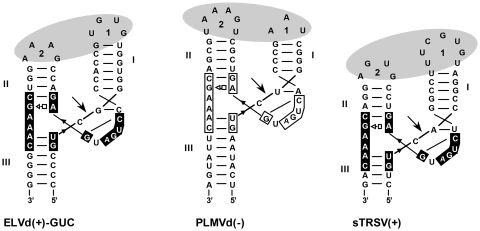Figure 1.
Secondary structures of the ELVd(+)-GUC, PLMVd(–) and sTRSV(+) self-cleaving hammerheads represented according to crystallographic data obtained for the Schistosoma mansoni and the sTRSV(+) hammerheads (9,13). Motifs conserved in most natural hammerheads are within boxes and self-cleavage sites are marked by arrows. Black and white backgrounds refer to (+) and (–) polarities, respectively. Dashes denote Watson–Crick (and wobble) pairs and the open square-triangle a Hoogsteen/sugar edge interaction. Nomenclature of helices and loops follows the standard criterion (43). Ovals represent the proposed tertiary interactions between loops 1 and 2.

